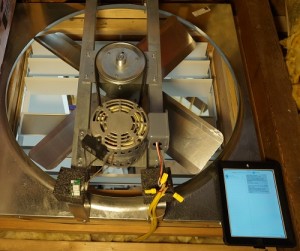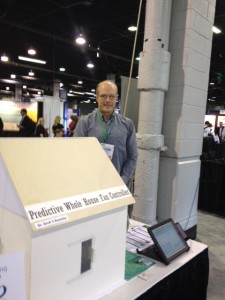
Predictive Whole House Fan Controller
Contestant: Brett Warneke
Semi-Finalist
Contact Information: bwarneke@linear.com
Summary
Whole house fans are an efficient means of cooling a residence, but they traditionally require significant attention from the occupants to monitor the interior and exterior temperature differential and then open and close windows at appropriate times. The Predictive Whole House Fan Controller wirelessly monitors temperatures inside and outside the house as well as household window states, requests daily weather forecast data and reported air quality conditions, and logs this data on a cloud service for analysis. The Controller sends XMPP notifications (Jabber instant messaging) advising occupants when to open or close the windows and then automatically turns on and off the whole house fan, reducing the effort to use the house fan while improving the efficiency of the system and thus the comfort of the occupants.
How does “Predictive Whole House Fan Controller” use Internet Technology?
The wireless sensors communicate with each other and the network manager using 6LoWPAN IP packets. On top of this, UDP is used to transport CoAP-like messages between the controller (a Raspberry Pi board) and the wireless sensor nodes. The controller then uses HTTP PUTs to publish the sensor data (temperature and window open/close state) to the Xively public cloud. The controller also sends HTTP requests over the Internet to wunderground.com and airnow.gov and receives back JSON-formatted weather forecasts and air quality reports. Finally, the controller uses the XMPP protocol to send instant messages to the occupants to tell them when to open and close windows and which ones the system recommends opening based on current temperatures.
Why did you choose to invent your prototype? What problem do you see that it can solve?
Last summer I installed a whole house fan in my home. While preparing for the installation, I was considering whether to implement a wireless switch, when it occurred to me that instead of simply replacing the hard-wired switch, the wireless network would actually provide value if it turned on the fan in response to opening the windows. In the interest of getting the fan operating before the end of the summer, I actually used a hard-wired switch. The IPSO CHALLENGE encouraged me to revisit this idea, add more Internet features, and actually implement it.
While being significantly more efficient at cooling a house than air conditioning, a whole house fan requires significantly more attention from the occupants to operate. First of all, a sufficient amount of window area must be opened before the fan is energized or else soot can be drawn in from the chimney or smelly odors can be sucked back through sink vents or from under the house. Secondly, if the fan is left operating for too long in the morning, the house can warm up as the outdoor air temperature rises. However, if it is left on too long at night, the house may become too cool. Furthermore, in the evening, occupants may not properly estimate when the outdoor air temperature has decreased sufficiently to start using the fan, so the house may remain uncomfortable for a longer time period than is necessary.
What is the practical application of your invention for the everyday user?
My invention simplifies the operation of a whole house fan while helping to optimize its effectiveness in improving occupant comfort. In so doing, it can eliminate the need for installing air conditioning, or if air conditioning is already installed, it can reduce its usage and thus lower the home’s energy consumption.
Are there plans to produce your prototype for the marketplace, or is it already a product that can be purchased/obtained?
There currently are no plans to productize the prototype, but I am open to discussions.
Why would you consider “Predictive Whole House Fan Controller” to be “innovative”?
Checking the weather forecast, air quality, and the indoor and outdoor temperatures followed by sending a notification to occupants to open/close windows is a new idea that is applicable to anyone, regardless of whether they have a whole house fan. Using window sensors to automatically turn on and off a whole house fan is not currently available. Incorporating a large number of indoor and outdoor temperature sensors to determine when the fan should be used and which windows are best to open is also a new concept, at least for residential ventilation. On top of all of this, the use of open Internet Protocols, such as sending the notifications using XMPP, which has clients available for any modern platform, rather than using dedicated apps, is unique.
What would you like to see in the future for the Internet of Things? Why should more companies utilize IP?
The big benefits of the Internet of Things will come about as the web of connectedness increases. As more things communicate with each other with their little bits of information, they will be able to do more for us to improve our lives.
Not only is IP, in a sense, the lingua franca of information networks, there is a wealth of development work that has gone into the components at the various layers of the Internet Protocols. By using them, companies can leverage this work to speed their time to market and include communications and interconnection features that they may not have been able to implement due to a lack of expertise.

